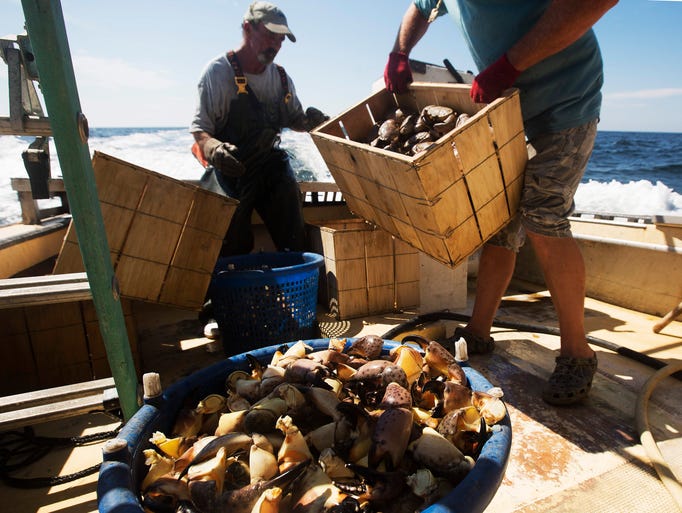As the 34-foot Lucky Lady rolled in 2- to 3-foot seas Thursday, trap after trap came up from the Gulf of Mexico crawling with stone crabs, many of them big males with jumbo claws.
A good opening day of stone crab season, which runs through May 15: The Lucky Lady landed almost 200 pounds of claws in 400 traps, or one-half pound per trap, which is considered a good day’s harvest (on opening day 2014, the Lucky Lady’s catch was 0.14 pound per trap).
“This is a lot better than last year,” said Robbie Borgerding, who’s been stone crabbing for 13 years, “This was 400 traps in one spot, and I have 3,700 traps out, so I’m excited. We could use a good year.”
Stone crab is one of Florida’s premier seafood products; from the 2004-2005 season through the 2014-2015 season (excluding 2005-2006, which was an off year due to hurricane activity), the annual dockside value of stone crabs was $22.46 million.
Over the past three years, however, landings have been down: From 1998-1999 through 2011-2012 (excluding 2005-2006), the average harvest was 2.75 million pounds of claws; from 2012-2013 through 2014-2015, the average was 2.12 million pounds.
“We’ve seen a lot of big males pouring in over the past couple of months,” he said. “It’s been real heavy farther north, around Cedar Key. Then the central Gulf and your coast turned on with big crabs.”
Why so many crabs and so many big males are crawling around now might have to do with recent rough weather, including heavy rains caused by a low pressure system in the Gulf during September and high winds from Hurricane Joaquin earlier this month.
“Crabs really like rough, muddied-up water,” Gandy said. “That gets them moving. And we had some nasty weather leading up to the season, and we haven’t had that for the past few years. But the proof is in the pudding whether there’s enough of a population to sustain a good season. The bulk of stone crab landings are always in the first couple of months, until December, then they trickle off after that.”
Most of Island Crab’s claws go to Pinchers Crab Shack, which owns 11 restaurants from Tampa to Key West. The Lucky Lady left the dock in Bokeelia at 6:30 a.m. and started pulling traps at 7:30.
For the past 13 stone crab seasons, Borgerding worked “on the stern,” pulling traps and removing crab claws (by law, commercial and recreational fishermen must remove claws from stone crabs and return the animals to the water alive); Thursday he drove the boat as two first-timers, Patrick Wilson and Joel Stoddard, were on the stern.
Stone crabbing is a relentlessly methodical process: As the boat came alongside each crab buoy, Stoddard snagged the line with a gaff and fed it into the hydraulic puller, which hauled the trap onto the stainless steel table on the stern; Wilson opened the trap and removed the crabs, tossing those with short claws into the water and putting legal-size crabs in a box on the deck (claws would be removed later), then he baited the trap with two pig’s feet and pushed it overboard just in time for the next trap.
Over and over and over, 400 times for six hours.
When all was said and done Thursday, Borgerding told Stoddard and Wilson they’d done “way, way, way” better than he’d expected. And stone crab season had started better than he’d expected. “I was scared,” Borgerding said. “It’s been so bad for the past few years. But this is good. Pinchers will be happy.”
Stone crab facts
Range: North Carolina to Cuba, the Bahamas and Mexico. Common throughout the Gulf of Mexico, especially Southwest Florida.
Diet: Larvae eat other microscopic animals; juveniles eat worms, small mollusks and other crustaceans; adults eat many kinds of mollusks and crustaceans.
Predators: Humans, octopuses, horse conchs, sea turtles.
Stone crab regulations
Season: Oct. 15-May 15
Gear restrictions: Spears, grabs, hooks and other gear that can injure the crab are prohibited.
Size limit: Claws must be at least 2.75 inches in length, from tip of immovable finger to end of first segment.
Recreational daily bag limit: One gallon of claws per person or 2 gallons per boat, whichever is less. One or both claws may be taken. Crabs must be returned live to the water. Removing claws from egg-bearing females is illegal.
Source: Stone crab season starts with a bang and big catches

